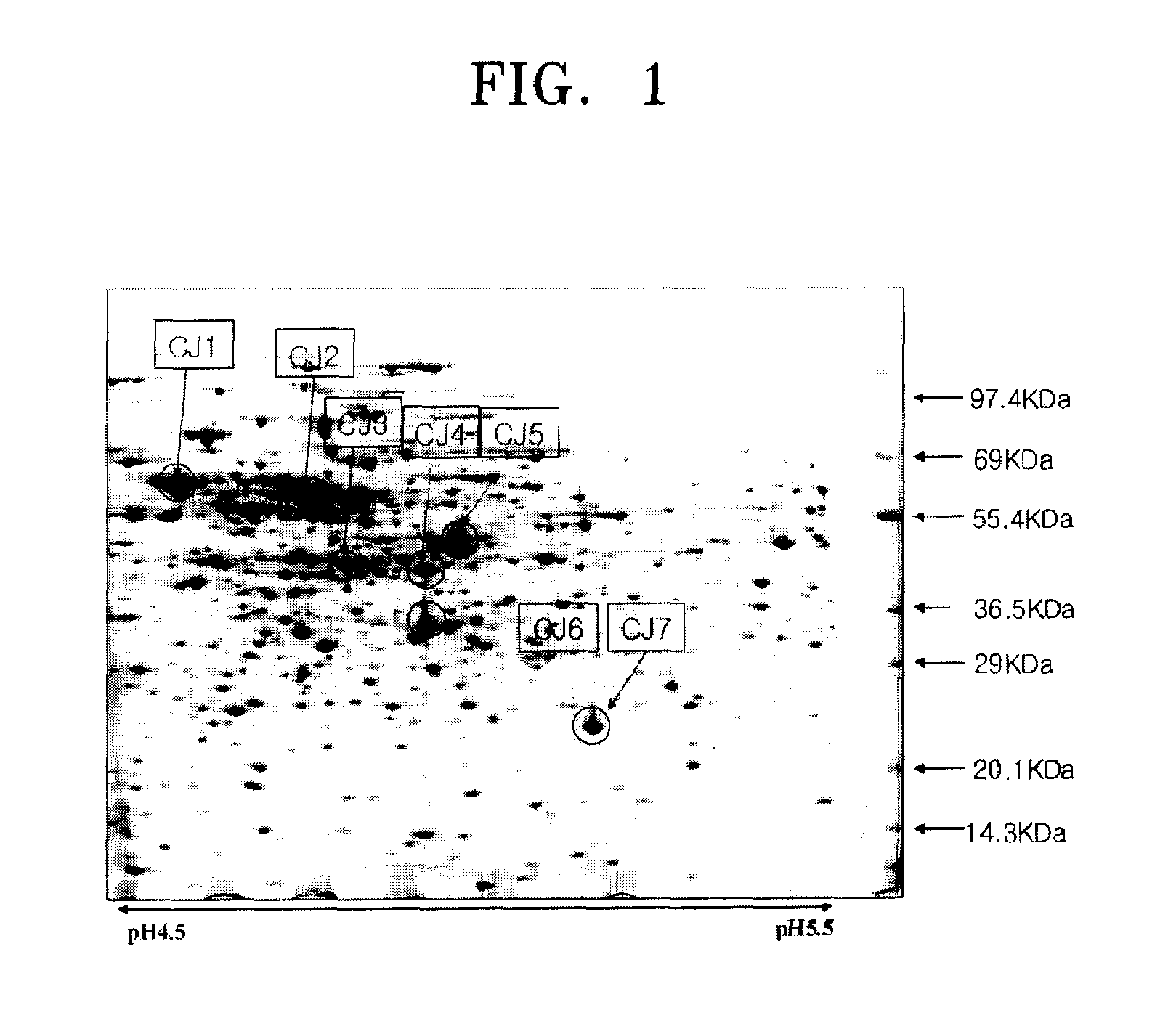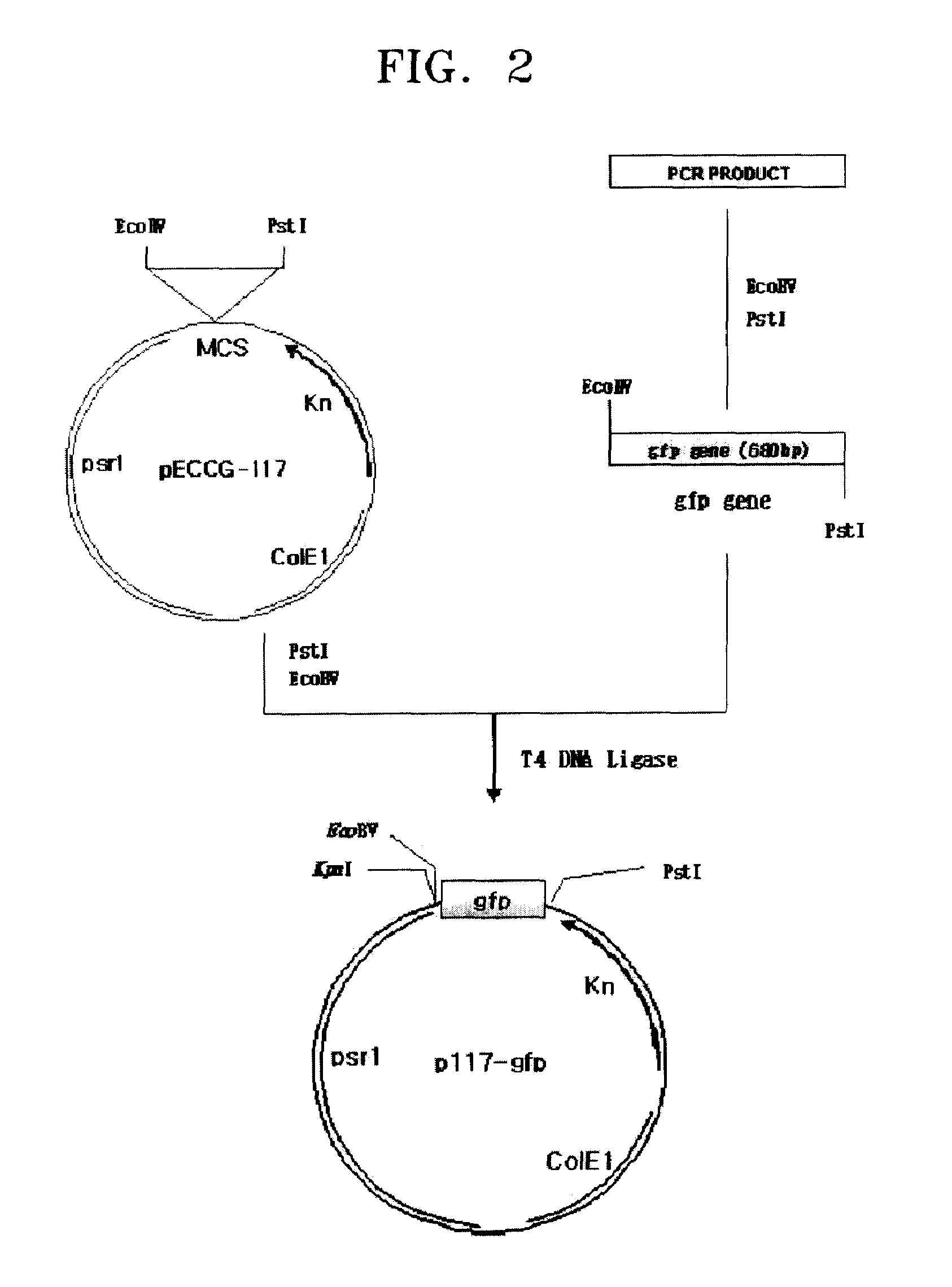Promoter sequences from Corynebacterium ammoniagenes
a technology of promoter sequences and ammoniagenes, which is applied in the field of new promoter nucleic acids derived from corynebacterium genus bacteria, can solve the problems of low efficiency of promoters and the inability of promoter dna that is separated from a i>brevibacterium /i>genus to be operable in other bacteria, and achieve efficient expression and expression
- Summary
- Abstract
- Description
- Claims
- Application Information
AI Technical Summary
Benefits of technology
Problems solved by technology
Method used
Image
Examples
example 1
Culturing of Corynebacterium Ammoniagenes CJHB100 (KCCM-10330) and Selection of Overexpresssion Protein According to Cultural Stages
[0028](1) Culturing of Bacteria
[0029]Corynebacterium ammoniagenes CJHB100 (KCCM-10330) were cultured in a medium having raw sugar of molasses (mixture containing 50% glucose and 50% fructose), At this time, the cell concentration was measured. Samples of the cultured Corynebacterium ammoniagenes CJHB100 (KCCM-10330) were harvested at an early stationary phase and stationary phases. The samples were centrifuged and the resulting upper solution was removed. The obtained cell pellet was lysed in a disintegrating buffer to produce about 100 μm of a bacterial extract.
[0030](2) Two-dimensional Electrophoresis Assay
[0031]The bacterial extract obtained from section (1) was diluted using 6M urea, 2M thiourea, 4% CHAPS, and 0.4% DTT to obtain a mixture with a total volume of 350 μl. Then, 7 μl of an IPG buffer and 3 μl of 1% bromophenol blue (BPB) were added ther...
example 2
Manufacturing of Recombinant Vector p117-cj1˜7-gfp Having Promoter Sequence and Confirming of Promoter Activity in Corynebacterium Ammoniagenes
[0046](1) Amplifying of Promoter Sequence from Genome of Corynebacterium ammoniagenes CJHB100
[0047]500 μg of chromosomal DNA was separated from 25 ml of Corynebacterium ammoniagenes CJHB100 culture incubated for one day, using a method suggested by Eikmann et al. (Gene, 102, 93-98, 1991). The separated chromosomal DNA was used as a template. PCRs were performed using primer sets (SEQ ID NOS: 10 and 11, 12 and 13, 14 and 15, 16 and 17, 18 and 19, 20 and 21, and 22 and 23) to amplify promoters of CJ1 to CJ7 for 30 seconds at 94° C., at 55° C., and at 72° C., repeated 30 times, respectively. As a result, respective promoter sequences pcj1 through pcj7 were amplified.
[0048](2) Manufacturing of Screening Vector
[0049]First, PCRs were performed using a pGFuv vector (produced by Clontech Inc, USA) as a template and using SEQ ID NOS: 8 and 9 as a pri...
example 3
Comparison of Activities of Tac Promoter and Promoter According to an Embodiment of the Present Invention in Corynebacterium Ammoniaqenes
[0057]In the present experiment, the activities of a promoter according to an embodiment of the present invention and a tac promoter that is conventionally used in Corynebacterium ammoniagenes were compared.
[0058](1) Manufacturing of Vector Containing Sequence of tac Promoter and GFP Gene Combined
[0059]First, a PCR was performed using a pKK223-2 vector (produced by Pharmacia Biotech, USA) as a template and using SEQ ID NOS: 24 and 25 as a primer in the same manner as in Example 1 to amplify the tac promoter sequence. The amplified product was cloned into a pCR2.1-TOPO vector (Invitrogen, USA). Next, the obtained tac promoter sequence was cleaved with restriction enzymes of KpnI and EcoRV and ligated to p117-gfp that had been cleaved with the same restriction enzymes to obtain a recombinant expression vector (p117-tac-gfp.)
[0060]The recombinant vec...
PUM
| Property | Measurement | Unit |
|---|---|---|
| volume | aaaaa | aaaaa |
| pH | aaaaa | aaaaa |
| pH | aaaaa | aaaaa |
Abstract
Description
Claims
Application Information
 Login to View More
Login to View More - R&D
- Intellectual Property
- Life Sciences
- Materials
- Tech Scout
- Unparalleled Data Quality
- Higher Quality Content
- 60% Fewer Hallucinations
Browse by: Latest US Patents, China's latest patents, Technical Efficacy Thesaurus, Application Domain, Technology Topic, Popular Technical Reports.
© 2025 PatSnap. All rights reserved.Legal|Privacy policy|Modern Slavery Act Transparency Statement|Sitemap|About US| Contact US: help@patsnap.com



